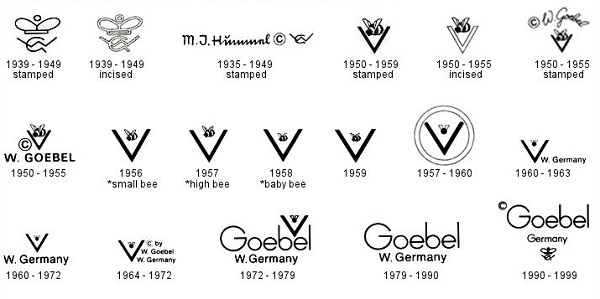
Like with so many other successful brands in this world, M.I. Hummel has had its fair share of copycats and forgeries. If you have stumbled upon such a fake, don’t despair. That little Hummel piece may actually still be worth something.
Read on for information on how to spot a fake or a forgery. Some counterfeits may actually be sought after by enthusiastic collectors. After all they say “Imitation is the greatest form of flattery”.
Contents
Spotting a Forgery, Fake or Reproduction
There are some shady people out there, that will try to take advantage of the evolutionary changes that Hummel has made with their products. From the variations of their trademarks and logos, to the slight changes to a figurine’s updated design. There are many different tricks that some of these people will try to use, to dupe unaware victims out of their hard earned money. In order to avoid some of these con jobs, it is best to familiarize yourself with Hummel’s trademarks, model numbers and markings.
For more information on identifying Hummel figurines, please read the following articles:
- Hummel Number Questions Answered
- How to Understand the Hummel Numbering System
- How to Identify Your Hummel Figurine
Differences in the Appearance
Do your research and crosscheck the figurines appearance against the Hum Number that can be found on its base. In an effort to pass some colored figurines off as uncommon or even rare pieces that have a white finish. Some con-artists would re-glaze a colored figurine with a white over-glaze. This can fool even some of the most dedicated collectors. Others may be able to notice features that were only meant to be found on a different design variation for that style of figurine. For this reason, it would be wise to have the an expert double check any figurine that you may be considering to buy, as Hummel has made changes to many of their figurine designs over the years.
A perfect example of this would be the the Goose Girl Hum Number #47, a figurine that has been released with several variations to it’s design. In earlier designs there were blades of grass between the two geese making them one solid form. As casting technology improved, later iterations reduced the size of the grass or even re-positioned the grass forward between the geese and the girl.
It is these differences in the designs that can cause some people to mistake a forgery for the real thing. It could be the addition, or even the complete removal of a feature that gives a forgery away. By familiarizing yourself with every part of a figurine’s design, you might notice the absence of a flower, a shoulder bag, or even a feather that should be in a hat. On the other hand you could see the inclusion of grass around a face, a belt when there should be none, or the aforementioned feather on the wrong side of the hat or tilted in the wrong direction. Someone who is well versed in the designs of Hummel figures, may be able to spot some of these differences for you.
Material Composition
It would be wrong of us to say that Hummel figurines were only ever made out of porcelain. As Hummel also used other materials such as earthenware for their prototypes, mold castings and rare releases. It is fair to state that the Hummel figurines that have been produced, have never been made from plastic, plaster of Paris, or any chalk-like plasters, substances or materials.
Many imitations, reproductions and fakes, are often made out of cheaper materials and can feel lighter then the originals. They may even have a strange texture to the touch. Being made of inferior compounds, many of these products don’t look anywhere near as good as the originals. Their color and sheen may be a lot duller then the real thing, or may even be far more vibrant and fluorescent in color.
While some of these imitations may be nothing but cheap knock offs there is still a demand from some collectors who seek to either collect these plastic/plaster based imitations on their own. Some collectors enjoy completing their Hummel collection by displaying the copies along side their originals.
Trademarks, Logos and Made In
Most imitations are made in Asian countries, such as Japan or China. Some people may view these copies as forgeries, others may think of them as nothing more then imitations inspired by the originals. Imitations that seek to only emulate and replicate the style and designs of Hummel figurines. There may also be some debate among collectors as to the validity of these products being allowed to be produced. Regardless of if people agree or not, most are not in breach of trade laws as they are not copying the Hummel figurines designs exactly, making them legally permissible.
As most of these products draw inspiration for their designs from the Hummel art style it is easy to mistake some of these imitations to be original Hummels just by looking at them. If you were to inspect these products however, the material quality differences as mentioned above can be noticed. You may also notice the absence of the proper Hummel trade marks and Hum Numbers branded into the base. There may even be a “Made in China”, or “Made in Hong Kong” branding on the bottom. Or a sticker that says “Original Hummel” or the figurines Hum Number. In either case it is advised to not trust these products as originals, and to seek the advice of an expert prior to purchase.
For more information on Hummel trademarks, see our article Find Out the Age of Your Hummel Figurine.
Popular Imitations and Reproductions
Aside from the aforementioned plastic figurines that some enthusiast seek to collect. There were two companies that released their own high quality figurines that look good enough to be actual Hummels. While they still remain unofficial, a collector would happily included them in their Hummel collections.
The Dubler Figures
As you maybe aware, during Wold War II, the Goebel Company was forced to cease production of their Hummel figurines, by the Nazi regime. This left an opening in the market. One that was filled by a New York based company known as Ars Sacra, a subsidiary of today’s Arc Edition. Using the original Hummel styles and designs, Arc Sacra produced a small collection of their own versions of the figurines. While they did make some Hummel reproductions, these figurines usually had a foil sticker that indicated that while it was a Hummel design, it was produced by Ars Sacra in the USA.
Dubler Figurines often had a copyright date and “B. Hummel” – Berta Hummel, being Sister Maria Innocentia Hummel’s birth name – incised into the top or side of the base. With either “ARS SACRA” or “Herbert Dubler, Inc.” as part of their markings. The Ars Sacra Josef Mueller Verlag publishing company was the first to produce products that featured the art work of Berta/M.I. Hummel in 1933. There could be as many as 50 or more, figurines that have been designed and produced by the Ars Sacra company. Most of which were made of plaster (Plaster of Paris, or other chalky plasters and materials), with a few that were cast in either bronze or silver.
These figurines where distributed throughout the united states, by the Crestwick Co. of New York. A company that would later become Goebel’s U.S based distribution company, Hummelwerk, before becoming Goebel Operations. It is this formal connection to Goebel, as well as the history and rights ownership Ars Sacra has with Sister Maria Innocentia Hummel, and the “B. Hummel” markings that has lead many to consider the Dubler Figurines to be a legitimate part of the Hummel Collection.
For more information on the history of Hummels, and the connection between Sister Maria Innocentia Hummel and Ars Sacra. See our article on The History of Hummel.
The Beswick/English Pieces
The enigma of the figurine world. The true history and origins of these models is filled with speculations and mystery. As no one truly knows where they came from or who made them. While the back stamp “BESWICK-ENGLAND” indicates that the figurines may have been produced by an established porcelain manufacture. When Royal Doulton bought out the company, they were unable to find any records that referenced the pieces in question. Nonetheless, this hasn’t squashed claims of legitimacy from many Hummel collectors.
There have been as many as twelve different designs that have been identified. Some with or without some variation of the Beswick backstamp, or the M.I. Hummel incised signature. Most have “Original Hummel Studios Copyright” inscribed in script letters, with others that have no markings at all. Despite the lack of evidence for a confirmation of legitimacy, many of these pieces remain highly sort after. With many serious collectors referring to the figurines as the “English Pieces”.
The twelve confirmed Beswicks are numbered 903-914. Mold number 907 has never been found, and as such there is some debate as to whether or not the model was ever produced.
- 903 – Trumpet Boy
- 904 – Book Worm
- 905 – Goose Girl
- 906 – Strolling Along
- 907 – (Unknown Model)
- 908 – Stormy Weather
- 909 – Puppy Love
- 910 – Meditation
- 911 – Max and Moritz
- 912 – Farm Boy
- 913 – Globe Trotter
- 914 – Shepherd’s Boy
Examples of Original Hummels and Their Imitation Counterparts
Chalk Figurines
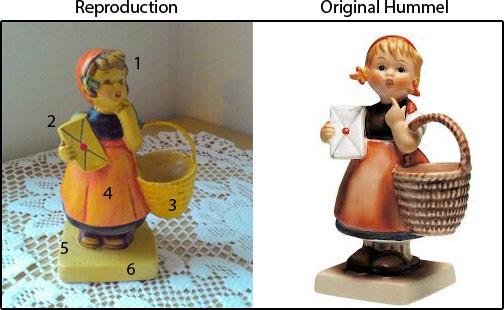
- Hair – The hair is a different color and style.
- Letter – This letter has a different color, position and has dark lines on the envelope.
- Basket – The basket is a different shape and color.
- Dress – The dress has different shading and blending. It also has creases in the skirt that the original one does not have.
- Shoes – The shoes are a different color and shape.
- Base – The base is a different color and thickness.
Reproduction Hummel
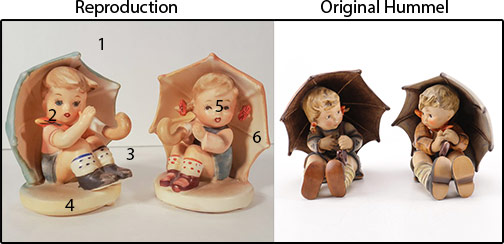
- Figurines – Overall the figurines has a different look and color scheme.
- Face – The face of Umbrella Boy has a different shape and expression. It is missing the rosy cheeks and detail of the expressions.
- Legs – The legs are in a different position the knees are against the chest of the figurines. In the original the legs are extended out. They are also a different color.
- Base – The reproductions have a base. The original figurines did not have a base.
- Face – The faces of Umbrella Girl has a different shape and expression. It is missing the rosy cheeks and detail of the expressions.
- Umbrellas – The umbrellas are in a different position and are a different color. These also do not have the details and points like the original.
Plaster Reproduction
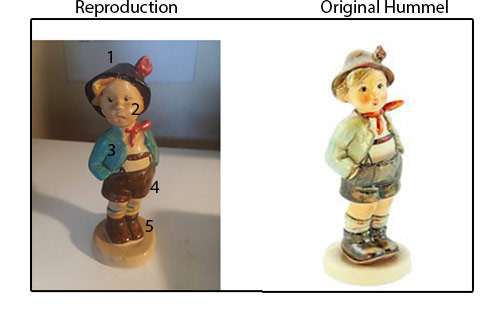
- Hat – The hat has a different shape and color scheme. The detail is also missing with the hat accessory.
- Face – His face does not have the sale expression, details or coloring. This reproduction is also missing the rosy cheeks that almost every Hummel has.
- Jacket – His jacket is a different color and is missing the blending details the original one has.
- Clothing – The coloring is a different color scheme and the details are missing. The spender band is spaced different and the handkerchief is different.
- Boots – The boots are a different color and shape. The boots are also flat on the base, the original one has the toes slightly lifted off the base of the Hummel figurine.
Plastic Reproduction
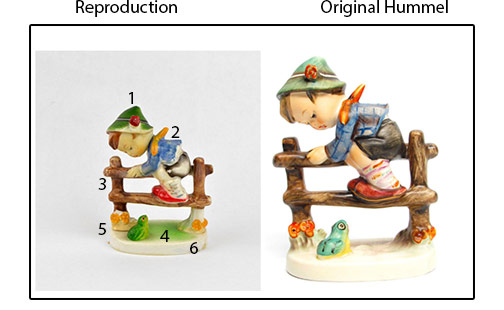
- Figurine – The figurine is light and you can feel it is made of plastic. Also the details and color scheme is different from the original. The figurine is also missing the glaze look of a porcelain figurine.
- Jacket – The plastic figurine does not have the line detail that the original one has. They also have different color schemes.
- Wood Fence – The fence has no to little wood grain detail like the original one does.
- Flowers – The little flowers do not have the detail the original one has, also the color is different.
- Frog- The frog is a different size and missing the details of the original figurine. This also has a different color scheme than the original one.
- Base – The base of the figurine is thinner than the original figurine.
I have a Hummel Figurine that has a solid V with the bee slightly above. Beside that is a r in brackets. (R). I’m just wondering what the the R is? I cant seem to find any info on it.
So if it says Goebel with Thailand underneath it’s a forgery.
I have a tmk 2 hummel (celestial music). The base is divided into quarters underneath. In one quarter it appears to say “copy” and W Goebel in script. Both are blue. I’ve never seen this marking and was curious as to what it meant. Thank you
We have one of the monks; the bottom has the V with a bee however instead of W. Germany it is spelled out as “Western Germany.” None of your authentic stamps has this spelled out so wondering if ours is a fake.
For years I’ve had a little girl in red polka dot scarf in a green dress with white apron on top with a doll in her left arm in blue dress standing alone on grass with a red flower next to her right brown shoe ? On bottom it has no impressions but a MK (maybe) painted on bottom next to air hole. I cannot find it anymore online. Is it of any value?
I have a Hummel with no trademark, but it has the number and Germany stamped on it. It appears quite old and has beautiful painted face. Could this be a forgery since there is no trade fee mark?
It’s possible that your Hummel figurine is a forgery if it doesn’t have a trademark stamp. Traditionally, all authentic Hummel figurines have a trademark stamp on the base that identifies the manufacturer and the period of production. However, there are some genuine Hummel figurines that were produced without a trademark stamp, especially during World War II when production was disrupted.
To determine if your Hummel figurine is authentic, you should look for other signs of authenticity, such as the quality of the painting and the level of detail on the figurine. You may also want to take it to an expert in Hummel figurines for an appraisal.
I’m confused with the markings one a Hummel we have. It’s the 4″ School Boy HUM 82/2/0 #922. The markings are Goebel – Germany then what looks to be the TMK-1 Crown in Blue… But there is also a small signature that looks like B 95. what does this all mean?
The blue crown symbol is the trademark used by Goebel from 1935 to 1949 and is called TMK-1. The small signature you mentioned is likely the artist’s mark, which is sometimes found on Hummel figurines.
I have the Ba Bee boy and girl set and on the back, the blue V with a bee, level to the top of the V is stamped where the string goes thru to hang it and on the opposite end of the back of the wall plaque, there are the words ‘West Germany’ stamped in black. The font is the same as the W. Germany font used. I think its from the 50’s or 60’s.
@Jami, The style of these markings suggests that the pieces were likely produced in the 1950s or 1960s, as this was a common period for such designs and stamps on Hummel figurines.
To provide a more accurate response or valuation, additional details like the condition of the figurines, any unique markings, and photos would be helpful. For more specific and detailed information, it’s advisable to consult a professional appraiser or a reputable dealer in Hummel figurines.